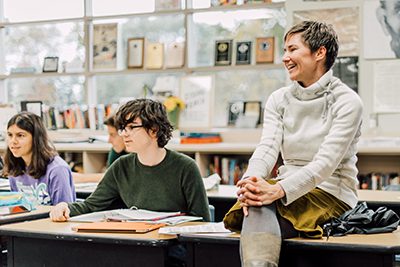November 7, 2019
 by Dr. Bill Hudson, Head of School
by Dr. Bill Hudson, Head of School
I meet throughout the fall in small groups with seniors to check in with them about how their year is going, what plans they have for next year, and solicit their feedback on our school and how I might be a better leader. Their stories fill me with great pride and joy, and sometimes bring a tear to my eye. This past Monday was no exception. Each student—some of whom have been here for many years and some of whom are newer—spoke of the school as family, of the remarkable sense of community that is safe, welcoming, and inclusive of all.
Small class size is indeed a significant factor that contributes to the close-knit community we enjoy. However, we are committed to small classes for another very important reason: they result in academic success and higher levels of achievement. Our teachers know this from their experience, but there is also an immense amount of research that confirms it.
Several high-profile studies have concluded that students in small classes obtain higher test scores, participate more in school, and demonstrate improved behavior. For instance, Project STAR (also known as the Tennessee Study) found that an average student assigned to the smallest classes had a reading score nearly 8% higher than students in the medium-sized classes. The smaller-class students, on average, achieved 9% higher math scores.
The average class size at MPA is 15, compared to the average public school class of 27 in Minnesota. Several of our teachers shared with me their frustrations with large classes prior to coming to MPA. For Upper School social studies teacher Summer McCall, it is deeply personal. “With a class of 35+ students, I felt like I was failing my students daily because I didn’t have time to grade, plan, or get to know them. Here, at MPA, I feel like I have time for my students, my grading, and myself. It has completely changed my life.”
Small classes provide the opportunity for teachers to truly know each student and therefore deliver an exceptional education. According to fourth grade teachers Deedee Stacy and Yamini Kimmerle, “Small class sizes enable us to connect deeply with each student. We have time to understand the way they learn, what trips them up, and what best motivates each one. Our feedback, both verbal and written, is personally tailored to help each student take his or her own unique next step in the academic journey.”
For teachers, less time is spent on classroom management, more time is spent on instruction, and there is more teacher support for learning. Middle School and founding teacher Anne Atchison knows that small classes allow each student to have a voice and presence in discussions. “There can be one-on-one or small group instruction, and feedback and celebration are more personal and frequent.” And, Ms. Atchison adds, “Students are more accountable since there’s no hiding!”
At MPA, we hold steadfast to a whole-child pedagogy. We know that the social, emotional, physical, and mental health of the student has a direct impact on students’ ability to learn and small classes are an essential part of the whole-child commitment. Spanish teacher María José Johnson believes that without making connections, the teaching-learning process does not happen and it tends to turn into mere instruction. “When I make connections and show students that I care about them, who they are and their needs and interests, the teaching-learning process becomes meaningful.”
Small classes enable teachers to personalize the educational experience for students. World language teacher Jess Blue considers herself to be very fortunate to have 10 students in her French V class. “As I write my vocab quiz for them, I find myself reflecting on how well I already know them from years of working together, and how I can tailor the exam to fit their interests. Every time I teach this level, I have the time and freedom to write curriculum and assessments that meet them where they are and engage them more deeply.”
With a student to teacher ratio of 7:1, at MPA we honor the unique learner inside each student. As Middle School director Dr. Jenn Milam puts it, small class sizes allow us “to know their social patterns, emotional needs, academic strengths and weaknesses, and the joys of their heart in a way that helps us connect with them in a more meaningful way.” Indeed, small classes make a big difference.